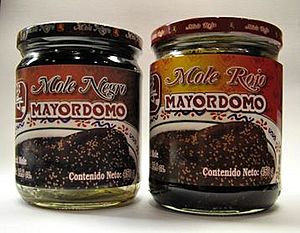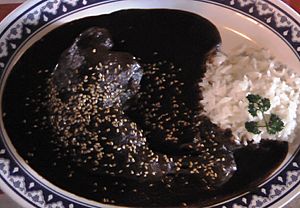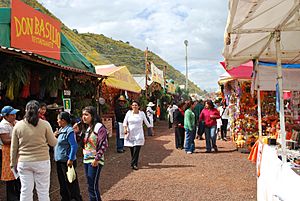Mole (sauce) facts for kids
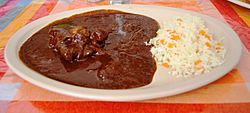
Chicken in a dark red mole sauce
|
|
| Type | Sauce and Marinade |
|---|---|
| Place of origin | Mexico |
| Main ingredients | Chili pepper , spice and nut |
Mole (pronounced MOH-lay) is a special sauce and marinade from Mexico. The word "mole" comes from the Nahuatl language, and it simply means "sauce." In Mexico today, "mole" is used for many different kinds of sauces. Some popular ones include mole poblano, mole negro (black mole), mole rojo (red mole), and mole verde (green mole).
Most mole sauces contain a mix of ingredients like fruit, nuts, chili peppers, and spices such as black pepper, cinnamon, or cumin. Sometimes, dishes like "mole de olla" (a beef and vegetable stew) use the word "mole" in their name, even if they are not a classic mole sauce.
Contents
The Story of Mole: A Mexican Tradition
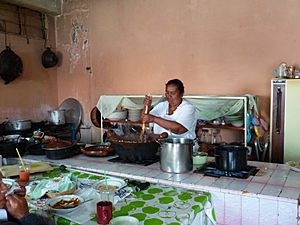
Two states in Mexico, Puebla and Oaxaca, are famous for being the birthplace of mole. The most well-known moles come from these two places. Mole is a symbol of Mexico's mixed heritage, combining both native and European ingredients.
How Mole Might Have Started
A popular story about mole's creation takes place a long time ago at the Convent of Santa Clara in Puebla. Nuns there were worried because the archbishop was coming to visit, and they had very little food. They gathered what they had: nuts, chili peppers, spices, old bread, and a bit of chocolate. They cooked an old turkey and poured their new sauce over it. The archbishop loved it! When asked what the dish was called, one nun said, "I made a mole," meaning "a mix." Over time, the word "mole" became the name for this special dish.
Another story says a monk named Fray Pascual accidentally invented mole when spices fell into a cooking pot of chicken. No matter the exact story, mole combines ingredients from different parts of the world, making it one of the first "international" dishes in the Americas.
Mole's Ancient Roots
The base of mole comes from ancient Mexico. People who spoke Nahuatl had a "chili sauce" called mōlli or chīlmōlli. Over time, new ingredients were added to these sauces, like different nuts (almonds, peanuts), seeds (sesame, squash), garlic, onion, and sometimes chocolate. The main things that stayed the same were the use of chili peppers (like ancho, pasilla, and mulato) and the sauce's thick texture. The first written recipes for mole appeared after Mexico became independent in 1810.
Making and Enjoying Mole
Making mole is a lot of work! It starts with one or more types of chili peppers. Classic moles from Central Mexico and Oaxaca often use several kinds of chili peppers, like ancho, pasilla, mulato, and chipotle. Other ingredients can include black pepper, cumin, cloves, tomatoes, tomatillos, garlic, seeds, dried fruits, and herbs. Some moles can have over 30 ingredients! If chocolate is used, it's added at the very end of cooking.
The Preparation Process
The ingredients are first roasted and then ground into a fine powder or paste. This can take a whole day if done by hand! Traditionally, families would work together to prepare it. Today, many people take their ingredients to electric mills to make the process easier. Many families have their own secret mole recipes passed down through generations, often made for special events.
The ground powder or paste is then mixed with water or broth and slowly cooked until it becomes thick and flavorful. It's usually cooked in a heavy clay pot and stirred often to prevent burning. Mole is always served over other foods, like turkey, chicken, or pork, and never eaten by itself.
Buying Mole
You can buy mole powders and pastes that are already prepared. Many markets in Mexico sell them by weight. These mixes have a very strong smell! Prepared mole sauce can last a few days in the fridge and freezes well. The paste can last even longer. Leftover mole is often used to make tamales or enchiladas.
Different Kinds of Mole
Oaxaca: The Land of Seven Moles
Oaxaca is known as "the land of the seven moles" because it has so many different kinds! These include mole amarillo (yellow), chichilo, colorado (reddish), manchamantel, negro (black), rojo (red), and verde (green). Each one has a different color and flavor, depending on the chilis and herbs used.
- Mole negro is Oaxaca's most famous mole. It's darker than mole poblano and includes chocolate, chili peppers, onions, and garlic. It's known for being very complex and difficult to make.
- Mole verde (green mole) must be made fresh with herbs and green chili peppers.
Puebla: Home of Mole Poblano
Mole poblano is perhaps the most famous mole of all. It's an ancient dish from the state of Puebla and is sometimes called the national dish of Mexico.
Mole poblano has about 20 ingredients, including sugar and cocoa (or chocolate). The chocolate helps balance the heat from the chili peppers and gives the sauce its dark color. This mole is often served with turkey at special events like weddings, birthdays, and baptisms.
San Pedro Atocpan, Mexico City
San Pedro Atocpan is a town near Mexico City that is famous for its mole. In the 1940s, a priest helped the community start selling their mole. At first, they ground the ingredients by hand, but with electricity, they could use machines, making it easier to produce more.
Today, San Pedro Atocpan makes 60% of all the mole eaten in Mexico and 89% of the mole eaten in Mexico City! Most families in the town make a living by preparing mole powders and pastes. They have their own secret recipes and are very competitive about making the best quality mole. Mole almendrado (mole with almonds) is a special mole from this area.
Other Moles Around Mexico
Many other types of mole sauces can be found across central and southern Mexico:
- Mole pipián is made mostly from ground squash seeds. It's usually green but can also be red. It's served with chicken, pork, or sometimes fish.
- Mole rosa (pink mole) from Taxco, Guerrero, is very mild and has a unique pink color.
- Chimole is also called "Black Dinner" because of its dark look. It's popular in Yucatan, Mexico, and Belize.
- Guacamole comes from the Nahuatl words for "avocado sauce."
- Huaxmole is a soupy mole often served with goat meat.
Guatemala
Mole guatemalteco is a dessert sauce made from dried chili, tomato, and squash seeds. It's often poured over fried plantains and topped with sesame seeds.
Mole's Popularity
Mole is one of Mexico's most important dishes, especially for big celebrations. Almost all Mexicans have tried at least one type of mole! It's most popular in central and southern Mexico.
Mole has a strong, unique flavor that some people need to get used to. In Mexico, if someone says "to go to a mole," it means they are going to a wedding! There's also a saying, "(estar) en su mero mole," which means something like "being in one's element" or "one's cup of tea."
Mole Festivals
Many places hold festivals to celebrate their local moles:
- The Feria Nacional del Mole (National Festival of Mole) started in 1977 in San Pedro Atocpan. It happens every October and features many restaurants and mole makers.
- The city of Puebla also has an annual mole festival. In 2005, they broke the world record for the largest pot of mole! It was huge and fed 11,000 people.
- The community of Santa María Magdalena in Querétaro holds the Feria del Mole y Tortilla (Mole and Tortilla Festival) every year.
Mole paste is also popular in other countries, like the United States, where it can be found in stores and online.
Images for kids
-
A rich "Green mole" with red rice
See also
 In Spanish: Mole para niños
In Spanish: Mole para niños


